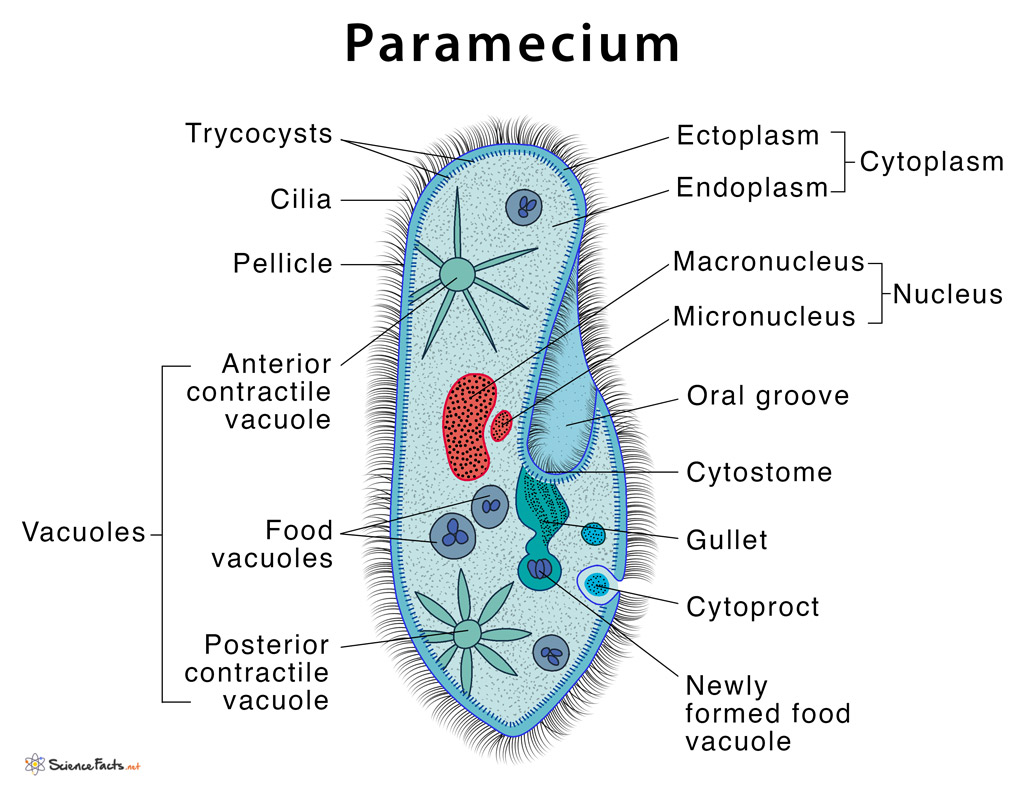Paramecium
What is Paramecium
A Paramecium is a free-living, motile, single-cell (unicellular) organism belonging to the kingdom Protista that are naturally found in aquatic habitats. They have a lifespan of a hundred, a thousand or even a million years. They are the most common of all ciliate organisms that are characterized by the presence of cilia all along their transparent and colorless body. Some of the common species of Paramecium include Paramecium aurelia, Paramecium caudatum, Paramecium woodruffi, and Paramecium trichium.
The word ‘Paramecium’ was coined in 1752 by John Hill and later studied in detail by O. F. Müller.
Where are They Found
They live widely in fresh, brackish, and marine water bodies. Paramecium is also abundantly found to live in stagnant basins, ponds, streams, and in decaying organic matter.
Scientific Classification
| Domain | Eukaryota |
| Kingdom | Protista |
| Phyllum | Ciliophora |
| Class | Oligohymenophorea |
| Order | Peniculida |
| Family | Parameciidae |
| Genus | Paramecium |
Structure
How Big is a Paramecium
Species of Paramecium vary widely in size from 50 to 330 µm (0.0020 to 0.0130 in) and thus can be viewed under a light microscope. Cells are typically oval, elongated, foot or cigar-shaped which are rounded at the front and pointed at the back.
Parts
The basic anatomy of Paramecium shows the following distinct and specialized structures in their cell:
1. Pellicle: Flexible, thin, elastic membrane consisting of outer plasma membrane and an inner membrane called epiplasm, but lacking a cell wall. Pellicle protects the cell from the outside environment.
2. Cilia: It is of two types. Primarily short, hair-like projections arranged in longitudinal rows throughout the body that helps in their movement. The others are long and fewer in number, present at the posterior end of their body that helps to catch and eat prey.
3. Cytoplasm: The jelly-like fluid that fills up the entire cell. The outer thin, dense and clear layer of cytoplasm that is bound to pellicle on one side is called ectoplasm. Below this lies the endoplasm, a fluid-type, granular cytoplasm that contains the majority of cell organelles. Being a cell that is non-photosynthetic in nature and performing respiration in presence of oxygen, the endoplasm of Paramecium contains organelles such as mitochondria, endoplasmic reticulum, a Golgi apparatus, and a phagosome-lysosome system similar to a eukaryotic cell.
4. Nucleus: It is of two types which differ in their shape, content and function:
a) Macronucleus: Kidney like or ellipsoidal in shape that is densely packed with DNA. The macronucleus controls all the vegetative functions of Paramecium hence called the vegetative nucleus. All Paramecium species contain a single macronucleus.
b) Micronucleus: Found close to the macronucleus, it is a small and compact structure, spherical in shape that is uniformly distributed throughout the cell. The micronucleus controls reproduction in Paramecium and is found to vary in number from species to species.
5. Vacuole: It is of two types:
a) Contractile Vacuole: It has a complex structure surrounded by several canals. It collects fluids from the entire cell and expels them out of the cell. It thus helps in maintaining the water and salt balance of the cell, a process known as osmoregulation. There are two contractile vacuoles present close to the dorsal side, one on each end of the body.
b) Food Vacuole: Non-contractile vacuole that is spherical in shape. They contain digestive enzymes that help in the digestion of food in Paramecium.
6. Oral Groove: Also known as vestibulum, it is a long, narrow depression found in the anterior side of the cell, lined with cilia which beat continuously to draw food inside the cell.
7. Gullet: Also known as buccal cavity, it is present at the posterior end of the oral groove. Gullet is the opening that collects food and passes them to the adjacent cell mouth. It eventually brakes off to form the food vacuole.
8. Cytostome: Also known as cell mouth, it is a narrow aperture in the cell membrane that helps to catch prey and send them to food vacuoles for digestion. The rest of the invagination is called cytopharnyx, which is a long tube-like structure that works in conjunction with the cytostome in order to import large molecules inside the cell.
9. Cytoproct: Also known as cytopyge or cell anus, it is the excretory pore of Paramecium that lies on the ventral surface just behind the cytostome. All the undigested food gets eliminated through the cytopyge.
10. Trycocysts: Spindle-shaped bodies found in the ectoplasm and filled with dense refractive fluid which may be used as an anchoring device, and as a means of defense against potential threats or for catching prey.
Characteristics
How do Paramecium Move
It travels using the whiplash movements of cilia. The coordinated action of cilia propels the organism forward in a counter-clockwise fashion. The Paramecium spirals through the water as it progresses. On hitting an obstacle it reverses the beat of cilia to swim backward for a brief time before resuming its forward progress. If it runs into an obstacle again, it repeats this process, until it can get past the object.
How do They Eat and Digest Food
Paramecium is mostly heterotrophic and thus a consumer that feed on microorganisms such as bacteria, algae, and yeasts for their nutrition. To obtain food, the Paramecium uses its cilia to make movement that helps to sweep the prey through the oral groove and into the cell. The food passes from the oral groove into the gullet from where the particles enter the cytostome. Once it enters the cell, it is gathered to form a food vacuole which then circulates throughout the cell by a streaming movement called cyclosis or cytoplasmic streaming. Once the digestion is complete, the vacuole starts to shrink and the digested nutrients enter into the cytoplasm. When the completely digested food particles reach the anal pore, it ruptures, thus expelling its wastes outside the cell.
How do They Respire
Paramecium takes in dissolved oxygen from the surrounding water through osmosis. The carbon dioxide that is breathed out is expelled by diffusion across the cell membrane.
How do Paramecium Reproduce
The most common mode of reproduction and the only asexual means found in Paramecium is binary fission. Here a fully grown Parameciacell divides at right-angle to the longitudinal axis of the body into two equal daughter cells which develop into new organisms. Nuclear division is followed by the cytoplasmic division. During binary fission the gullet along with the two nuclei undergoes division to be distributed equally among the two daughter cells.
Sexual Reproduction
During unfavorable or stressful growth conditions such as scarcity of food, Paramecium reproduces by sexual means, which are of following types:
a) Conjugation: Two Paramecium of compatible mating types fuse temporarily and exchange genetic material. Conjugation results in rejuvenation and formation of four daughter cells from two participating mother cells. An individual cell has to multiply asexually at least 50 times before participating in conjugation.
b) Autogamy: Also called self-fertilization, it is similar to conjugation but occurs within a single individual without the transfer of genetic material. As a result of autogamy, a new macronucleus is formed in the daughter cells which rejuvenate the cell by increasing its vitality.
c) Endomixis: It is a process of nuclear organization in a single cell. At the end of endomixis four daughter Paramecia cells are produced from a single individual from divisions of the micronucleus.
d) Cytogamy: It is less frequent among all reproductive processes. In cytogamy two Paramecia cells form a pair and become attached at their oral surface as in conjugation. But unlike conjugation no nuclear exchange takes place between the individuals. Similar to autogamy a new macronucleus is formed in the daughter cells which rejuvenates the daughter Paramecia cells.
Importance to Humans and the Environment
- Plays an ecologically important role in the carbon cycle where they eat upon the dead organic matter in addition to the bacteria, further aiding in decomposition.
- Helps to control algae, bacteria, and other organisms of kingdom Protista that can be found in water. They can also help clean up tiny particles of debris in the water bodies.
- Makes an ideal model organism that are well suited for biological study as most Paramecium species can be cultivated easily in the laboratory
FAQs
Ans. Although a protist, Paramecium is not known to cause any infections or diseases in humans.
Ans. Paramecium are eukaryotic organisms with well-developed nucleus and membrane bound organelles and thus not a bacteria which are prokaryotic in origin.
Ans. Paramecium is similar to E. coli in that they are both single-cell or unicellular organisms.
Ans. Conjugation is considered a sexual process and not a mode of reproduction in Paramecium because it only involves exchange of genetic material between two participating cells with no new organisms being formed.
Ans. Although both are unicellular organisms, amoeba moves by forming pseudopodia whereas Paramecium uses cilia to for their movement.
-
References
Article was last reviewed on Thursday, February 2, 2023







Understood so clear
Good